Glimpses of Meridian, Mississippi |
Who Stole the Pole? |
|
|
A "Making it better" project in Meridian |
| OK -- so this isn't exactly "exclusive" Meridian, -- and there really isn't any mystery about who, what nor why. But it was strange recently to come home after making a service call to find that a 100 foot utility pole that is normally across the street - wasn't. This isn't something that happens very often - either - it's a first for us... Meridian - being a fairly large town with a very busy downtown that includes many facilities who's operations are very critical has a very good electrical supply infrastructure that is owned, operated and maintained by Mississippi Power - a subsidiary of the Southern Company. Downtown has one of it's primary feed points from Mississippi Power's "grid" - located just south of downtown in a substation that can be fed from either of two primary grid lines - one coming in from the east up "B" street - and the other that comes in from the south along the south frontage road, up Grand Ave., "C" street then up 23rd Ave. These primary grids are three phase 110,000 Volts (!!!) that are carried by some very large utility poles - much larger and taller than "typical" distribution lines (as noted - 100 foot tall). Until recently - these utility poles were made of wood - which has some advantages - compared to a lot of other materials - it's relatively inexpensive; they are a "renewable" resource; and they withstand "abuse" fairly well - as wood tends to "bend" rather than just "snap" as some other materials. There are "issues" with wood, though - wooden utility poles - even when well cared for -- has a limited life span of 30 to 50 years; wood can become conductive when wet, especially if hit by lightning which can leave carbon traces that are conductive; and of course - wood can be attacked by insects, cars, trucks, and even people who can do damage - any single instance may not be serious - but it can add up - shortening the life of the pole. In the above article - the "Mystery Helicopter" was found to be doing an aerial survey of the transmission grid lines running along my street. Now we see one of the results of that survey. Those poles have been here as long as any of us can remember - which goes back more than 30 years. Mississippi power has maintained these poles quite well - several years ago - they up-graded all of the insulators - which we very much appreciated - as some of the old ones (and the poles they were mounted on) were "leaking" current - not enough to be a major problem - but enough to cause a lot of static on our radios. They also come along every so often and treat the base of the poles - we assume protecting them against termites and other things that might do harm to the wood. However - there comes a time - when they need to be replaced. And that time is now. As noted - these poles are much larger and taller than "typical" 35 - 50 foot utility poles - so changing them out is not as simple a task. So this section shows a pole replacement - one that required a slightly different approach because of it's location. It was also easy to watch - as it's right across the street. |
|
|
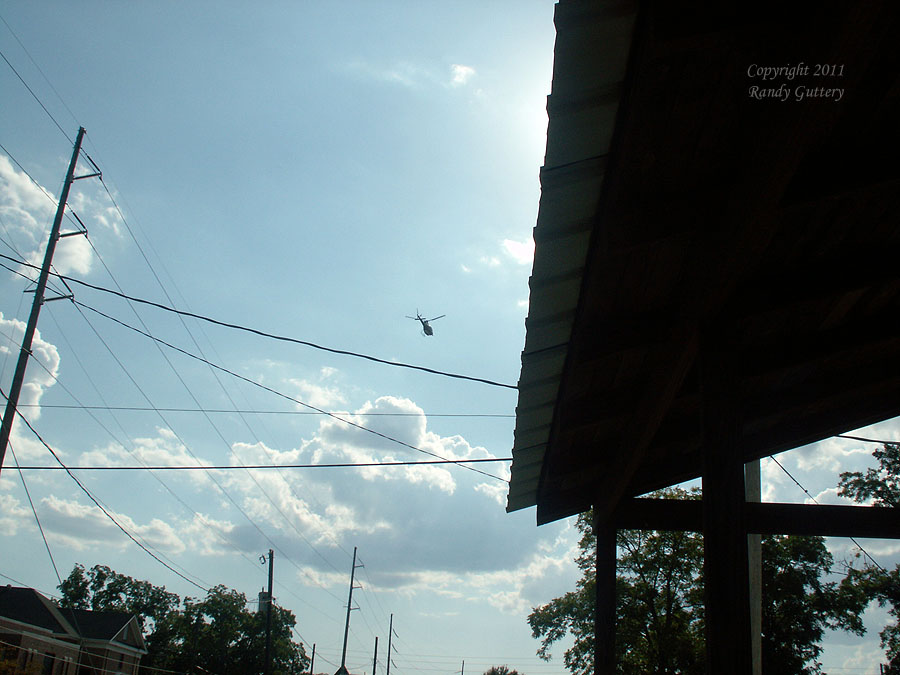 |
| Here is that helicopter making a survey run of the line along "C" Street. The pole on the left - is the subject of this story.
("Mystery Helicopter" story is in Glimpses: Planes part 5) |
|
|
 |
| Here - on the left -- is the original wooden pole - being wood and not all that strong - it has a guy wire to help keep it straight against the load of the wires. This is particularly needed in this case - as all of the wires are on one side of the pole. (The guy wire in the foreground is for one of the "regular" utility poles in my front yard). |
|
|
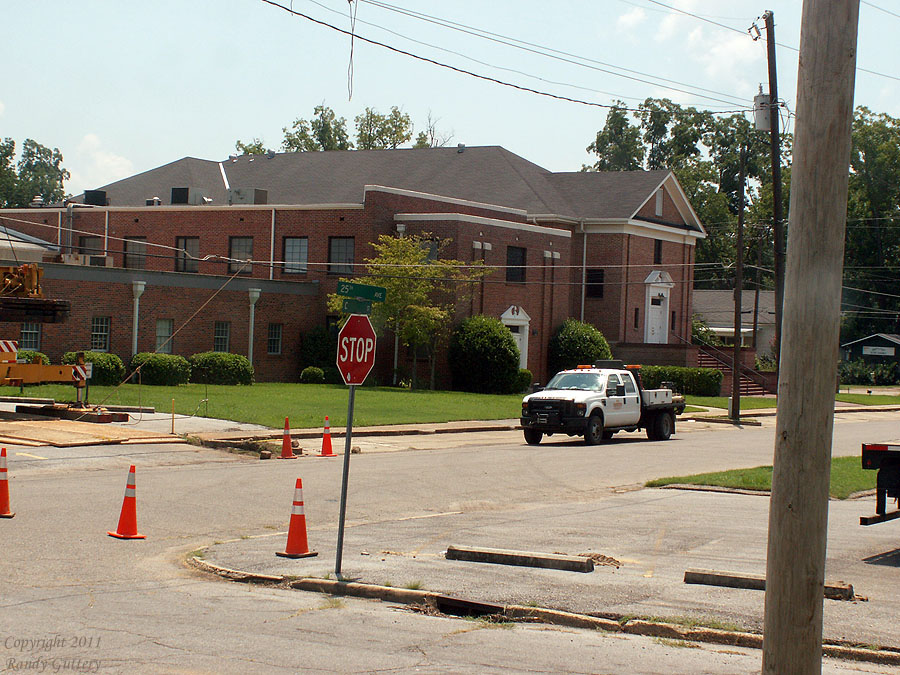 |
| As I noted earlier - the location of this pole required a different procedure than usual. Most of the time - there is enough room that the new pole is installed beside the old pole - then the wires and any other equipment mounted to the old pole is transferred to the new pole. However - in this case - there isn't enough room to do that as it occupies a small area between the church's drive way and street parking spaces; so the original pole had to be removed first - and it's hole enlarged for the new pole. The workers were just starting as I left just before 8 o'clock AM by the time I got back two hours later - the old pole was gone. |
|
|
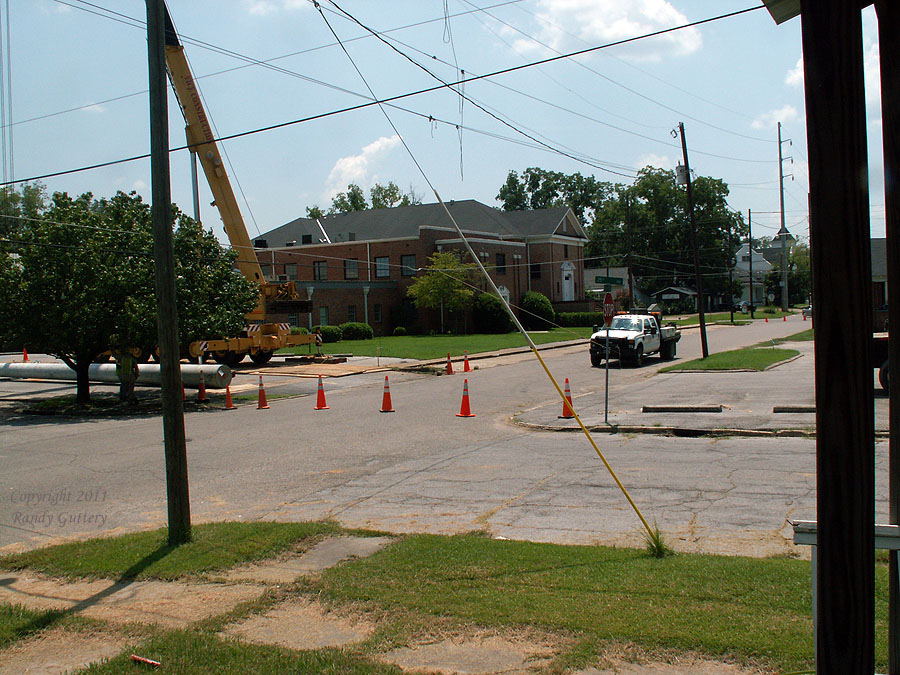 |
| As you can see - the lines have been left "just hanging". Also note the bonding (grounding) cables. These prevent the workers from receiving a shock should they come into contact with any of the wires. Yes - the power to these lines is off (110KV); but when wires run along other wires that are energized - those "dead" wires can pickup "induced" voltage - just like transformer windings. Those ground lines drain any induced current to ground so it can't harm anyone coming into contact with them. Also notice that the crane has a bonding cable to an independent ground (stake) as well. When dealing with power lines - safety is the highest priority. |
|
|
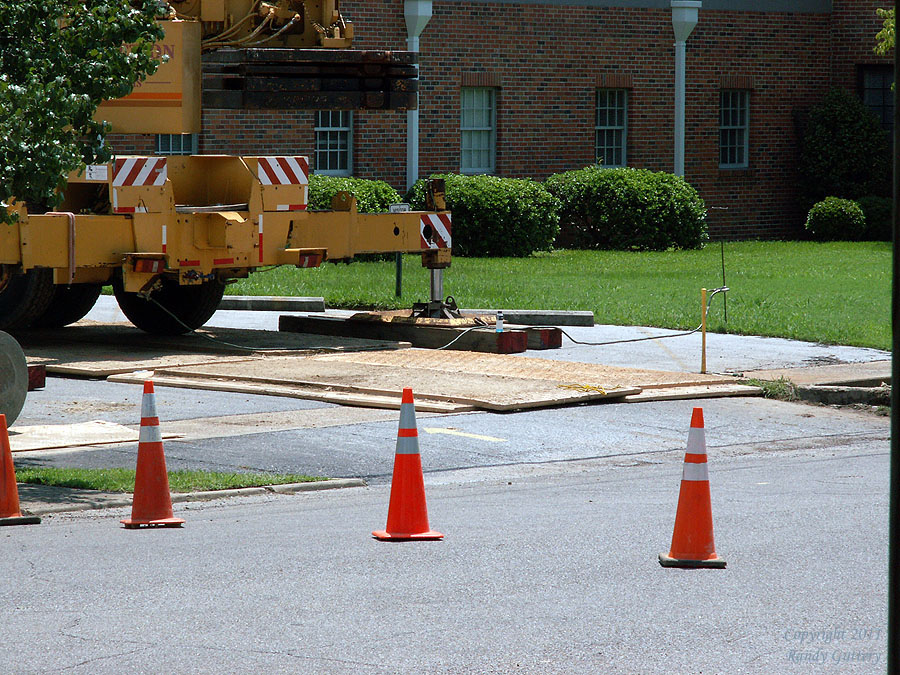 |
| The Crane's safety ground |
|
|
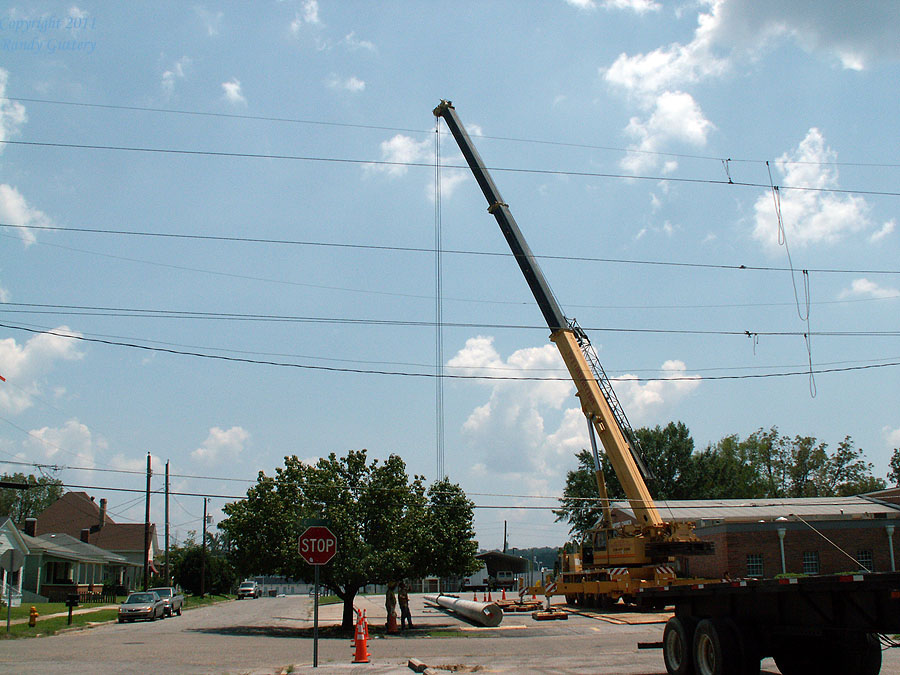 |
| The big crane starting to lift the pole. |
|
|
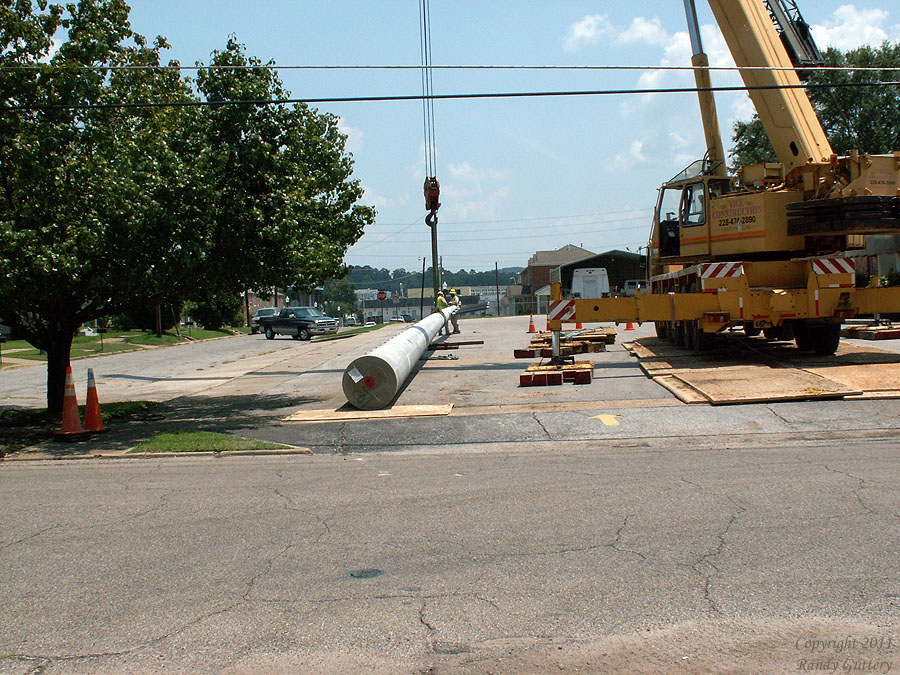 |
| Workmen install insulators. |
|
|
 |
| They don't look that big from the ground - but they are. The workmen give a good sense of scale. |
|
|
Click here for video of lift and set --> |
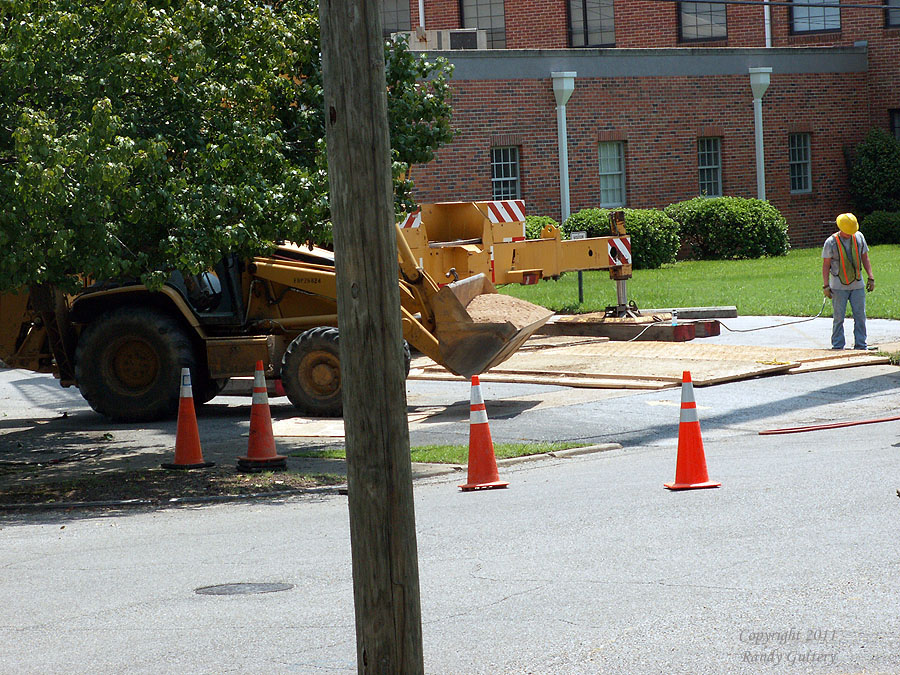 |
| With the pole set in place - a mixture of sand and dirt is used to fill around the pole - |
|
|
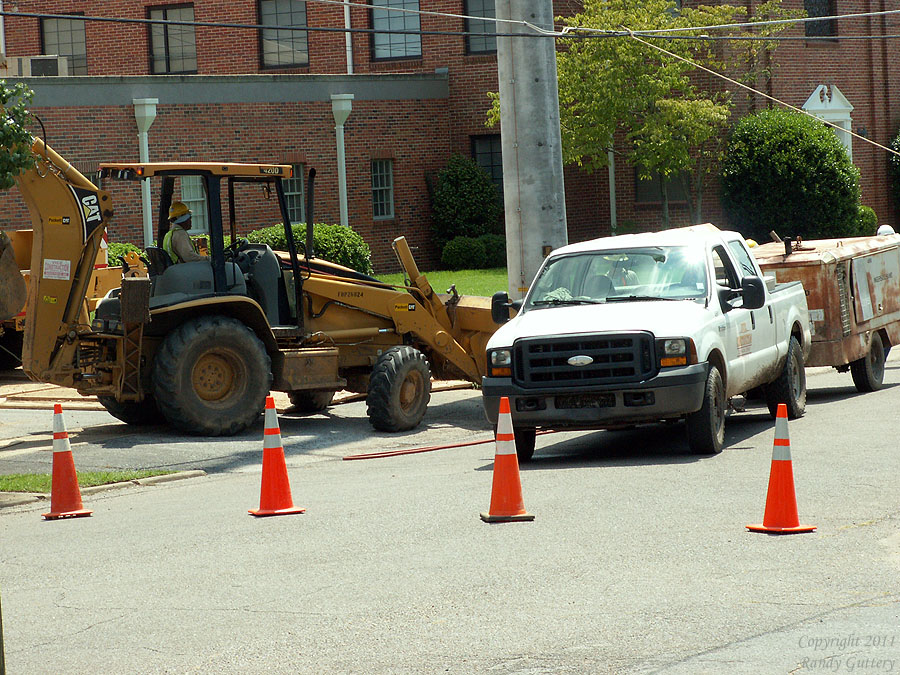 |
| One load of back fill being dumped in... |
|
|
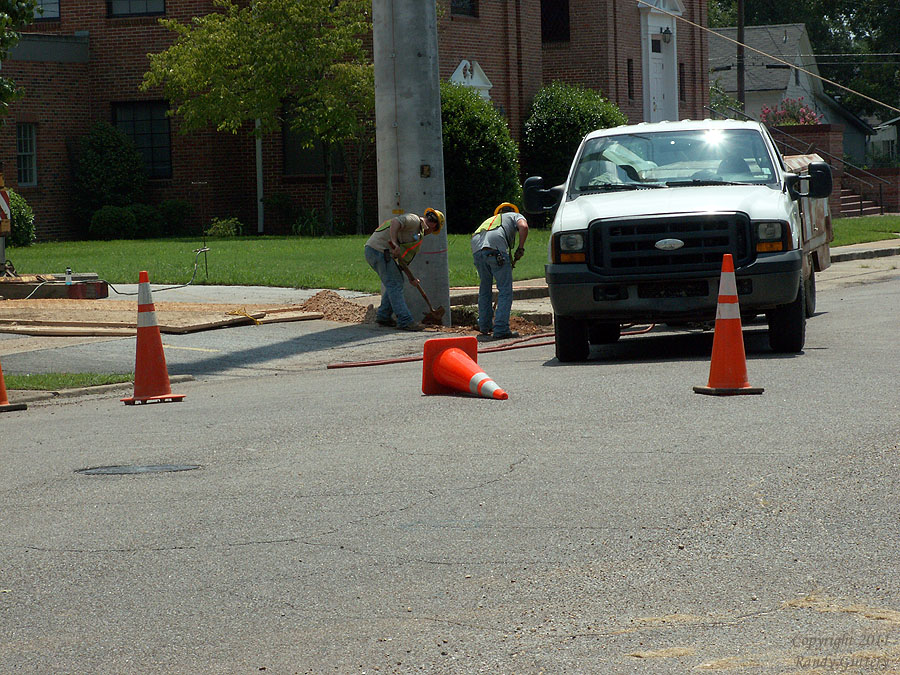 |
| While machinary is nice - sometimes there is no substitute for hands-on manual labor. |
|
|
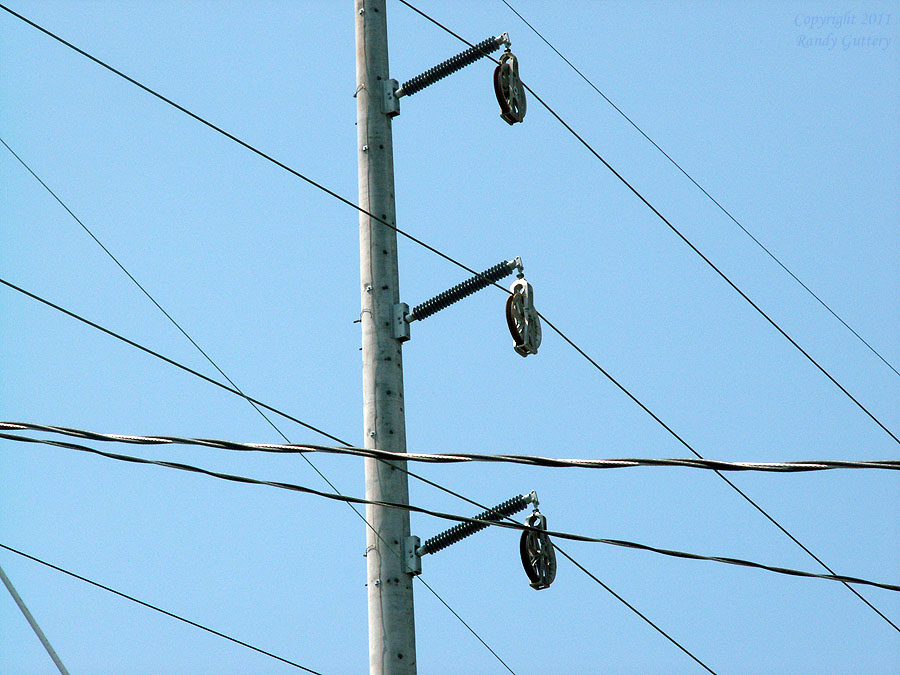 |
| Once the pole was set - a workman in a high-lift cherry-picker strung the lines onto the insulators. While wire tension, etc. is being adjusted the lines are run through pulleys so they can move as needed. |
|
|
 |
| And the new pole is almost done. Note some of the "other" wires and cables are just "tied" to the pole until another Mississippi Power worker can come along and "re-do" those tie points. |
|
|
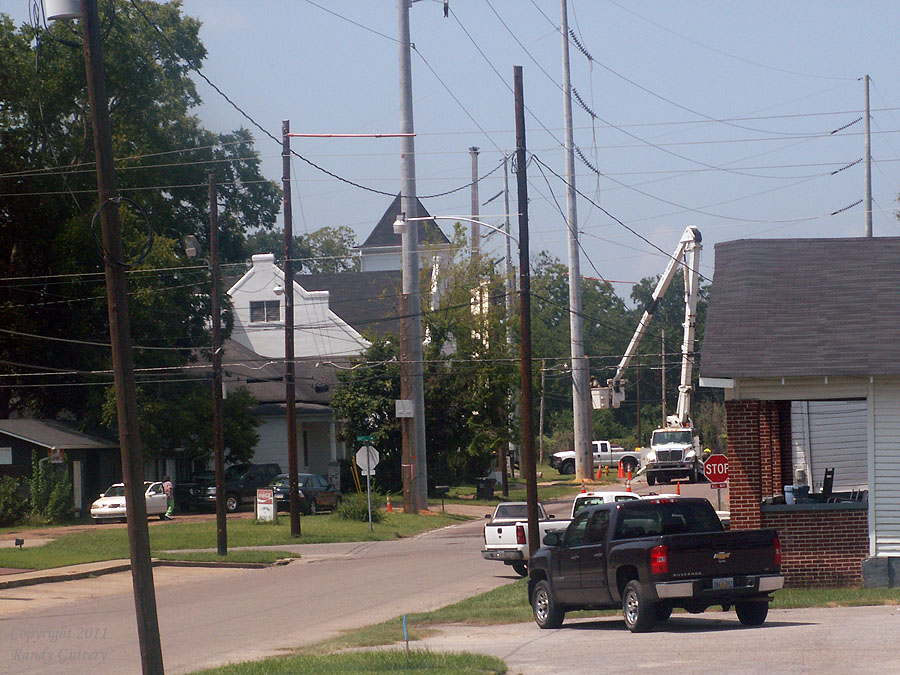 |
| In fact - just up the street - that very task is being performed by another worker. The "stump" of the old pole can be seen just beyond the new pole and wires, cables, and "other" equipment is being transferred from one to the other. Some "stumps" are left in place to hold "stuff" - rather than adding to the "load" of the new poles. What the criteria is - I have no clue - but a few are left standing here and there. If you notice just past the intersection - another ":stump" with a large box. Time will tell what "they" decide to do with that. |
|
|
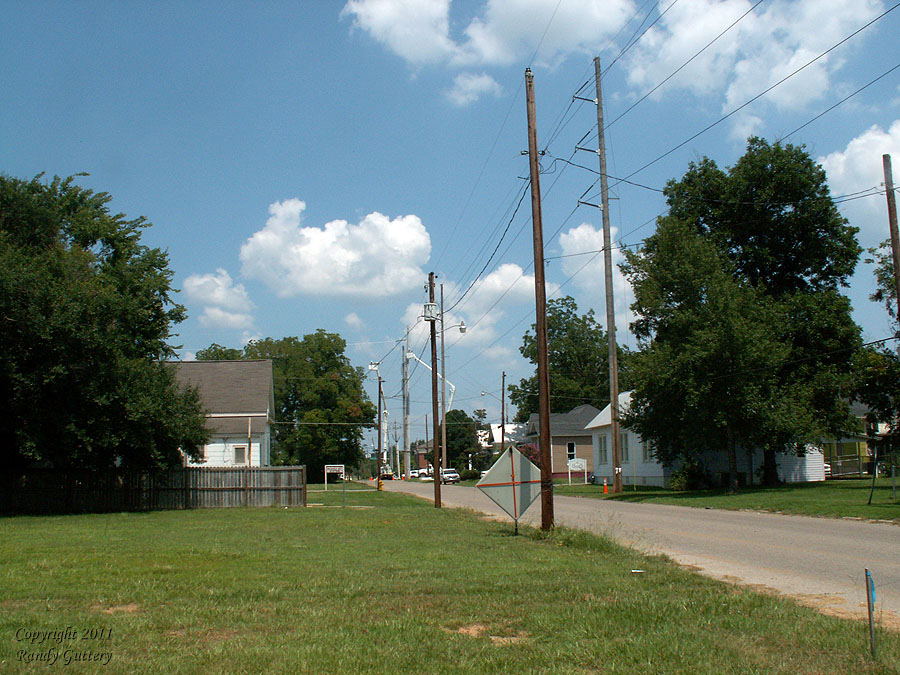 |
| Looking back the other direction (east) where the lines make the turn north to go the block to the substation - workers are busy on moving the lines from old to new, etc. |
|
|
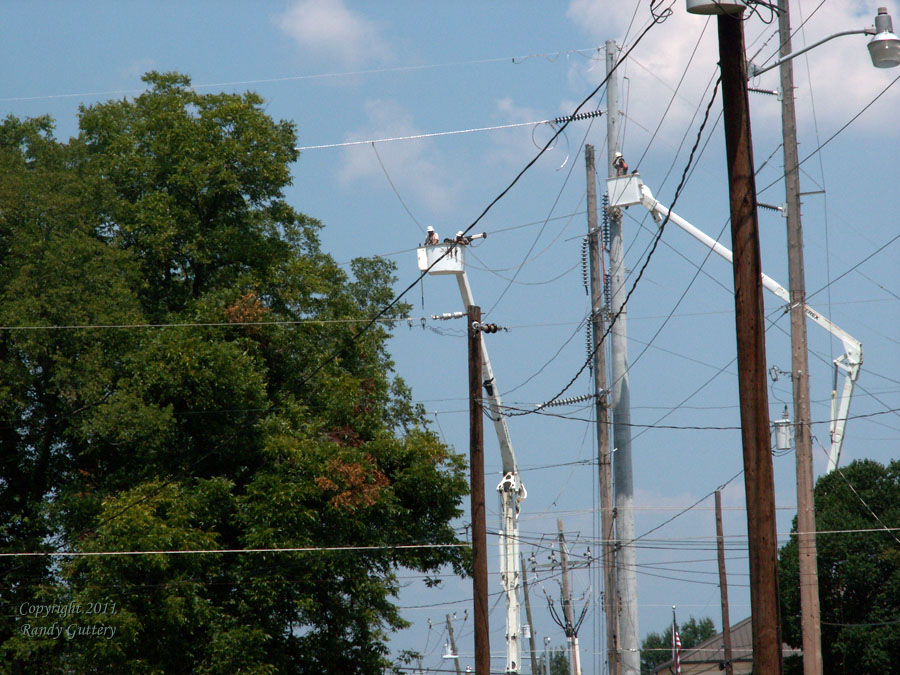 |
| "Zooming in" - we can see that they aren't "just" transferring lines - there is some new aluminum glistening in the sun... new lines being installed - at least in this area. |
|
|
 |
| Looking up B Street - a "new" pole and an "old" pole as each main grid line makes the transition down to the substation. Note the corner poles are two-piece to better accommodate transportation and installation. These corner poles are truly massive units. |
|
|
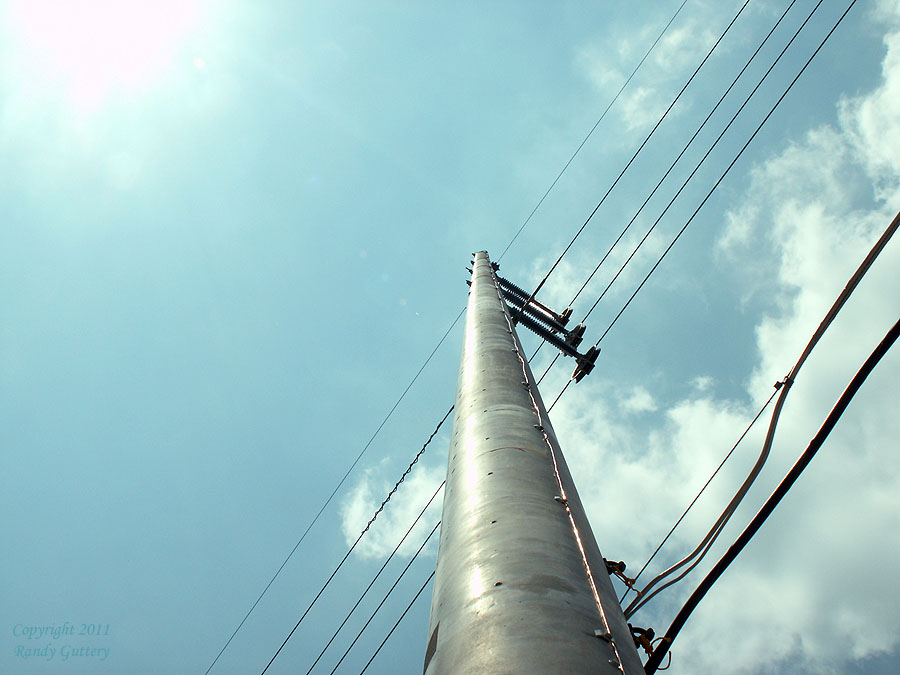 |
| Looking straight up the new pole - one massive unit. Here are some specifications: Manufactured by = Valmont Newmark Type / class = CLP2 / H7S spun concrete Height = 100 feet Diameter (at ground level) =30" Twist resistance (moment) = 751 Ft-KIP (751,000 ft lbs) Weight = 25,400 pounds Expected life span = 75 - 100 years A word about Valmont Newmark - they are "neighbors" - with several plants in various parts of Alabama - including Tuscaloosa. An "interesting" thing about their "spun" concrete poles - they are extremely strong - and several models exceed the "traditional" requirements of ANSI 50.1 which is the U. S. "standard specifications" for U. S. Utility poles. ANSI rating runs from 10 (light weight light duty pole) through 1 (very strong) through H1 - H6 - the strongest under that spec. Certain Valmont poles are spec'd well beyond that - out to H10 and higher on special order. The H7 rating of this pole is impressive enough - however - the "corner poles" on this project are two-piece - and spec'd at H10. There were many of this series Valmont poles were in use in Florida when Hurricane Andrew blew through - not one of those cement poles failed. |
|
|
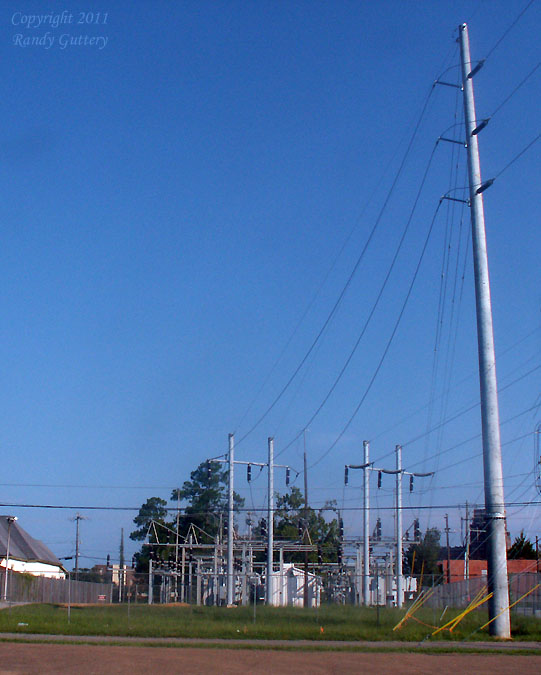 |
| Here is one of those H10 Spec'd poles - To get both it and the substation in the same shot - I'm using a wide-angle that is approaching a "fish-eye" effect. Here are details about this pole:
Manufactured by = Valmont Newmark This picture shows the feed line that comes in up C Street as it enters the substation. First stop is the incoming switching... |
|
|
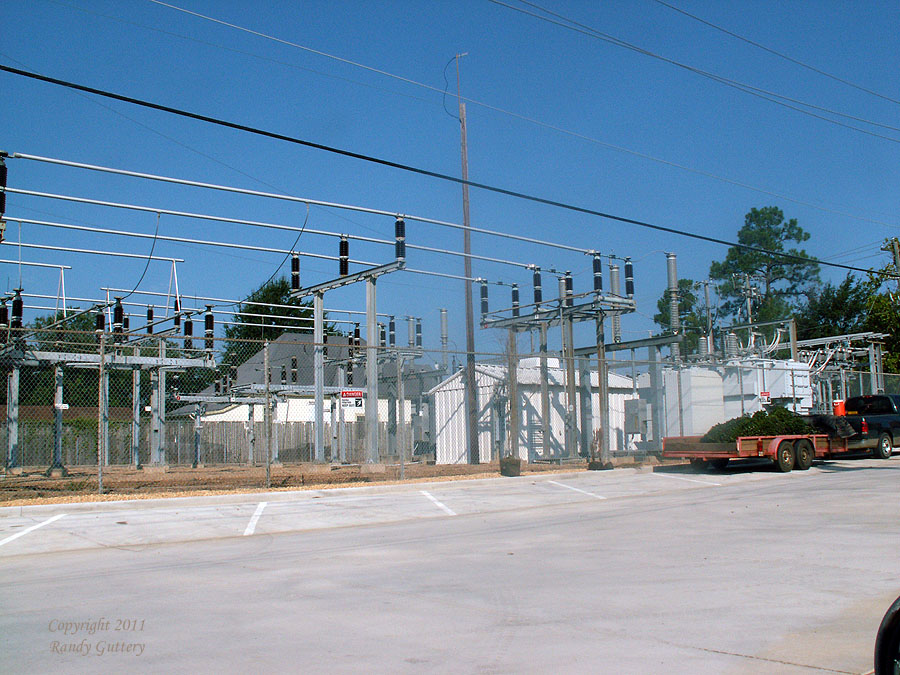 |
| These switches allow the incoming feeds to be sent to either of the transformers - or both - split - or paralleled. |
|
|
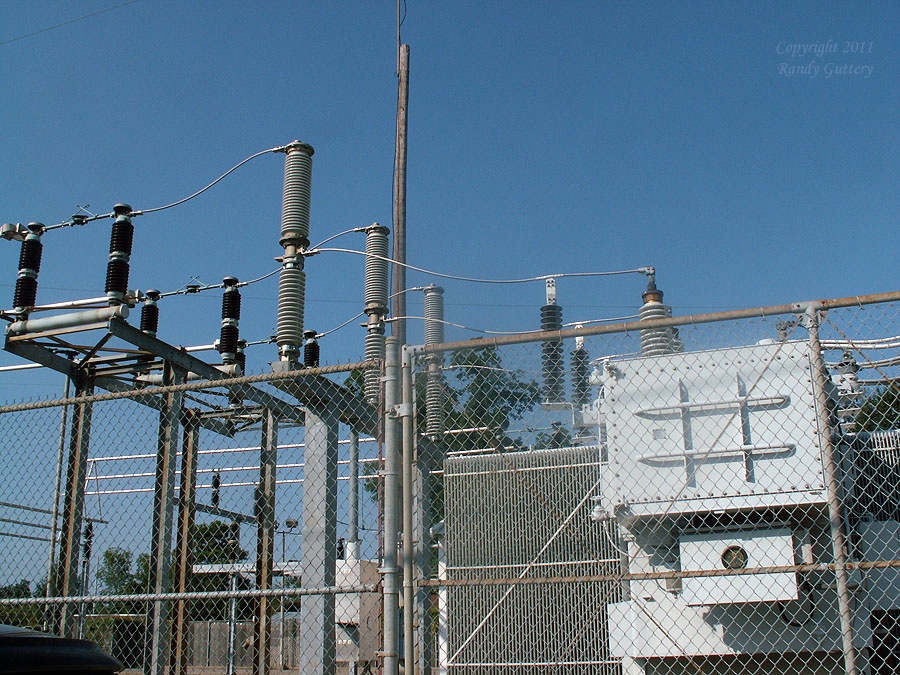 |
|
|
| Each step-down transformer has it's own input / isolation switch between it and the input switching set. This is all at 110,000 Volts AC (three phase). On the top right-end of the transformer is the 7.8KV "distribution" feed. |
|
|
 |
| One of the two step-down transformers is on the left - the other just to the right of the small building. The output of the step-down transformers is actually a group of "taps" of available voltages to accommodate various load requirements. Once the appropriate "tap" is selected - the output goes to the output selection switching matrix. Transformer one and or two can be switched to handle the entire load - or they can be split between two load paths - again - to meet demand and operational requirements. |
|
|
 |
| Here - the 7800volts three phase is sent via underground cables and up to distribution poles. There are two circuits here - one set going west - the other going east. The pole at the very left has a third feed - while a forth feed emerges on 23rd Ave. Initially heading south. |
|
|
| Thanks to representatives from Mississippi Power, Vice Construction and Valmont Newmark for information and cooperation in providing this "Glimpse of Meridian". |
| All images copyright © 2011 Randy Guttery except as noted. Page Copyright © 2011 Common Cents Computers |
|
|
| Return to Glimpses Main Page |